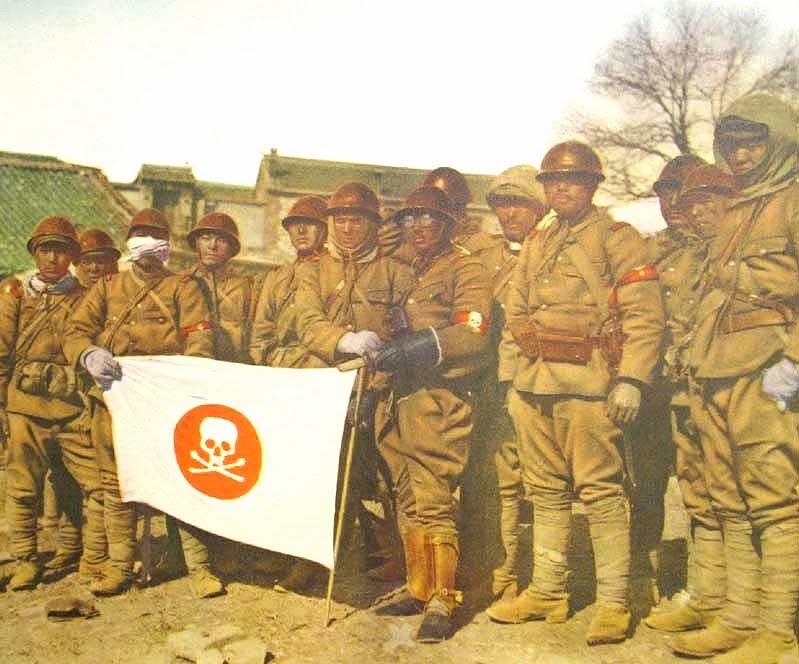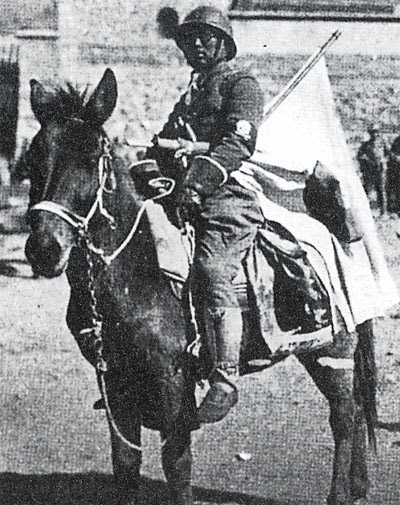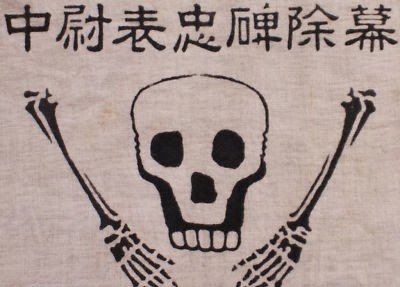Japan’s Skull Squadron (II)
- By Guest blogger
- 13 April, 2014
- No Comments
 In the second of two articles about Japan’s Skull Squadron, first carried on the Warfare Historian Blog, we look at the uniforms and equipment of this elite unit, active for several years in Manchuria:
In the second of two articles about Japan’s Skull Squadron, first carried on the Warfare Historian Blog, we look at the uniforms and equipment of this elite unit, active for several years in Manchuria:
The Skull Squadron and its leader, Lt Ikagami, would have been dressed in mostly similar uniforms and equipped with the base weapons and equipment of the Kwantung and the Imperial Japanese Army during this time. Most infantrymen were armed with the Arisaka Type 38 rifle, introduced in 1905, which fired a 6.5 x 55 mm round. They were well trained in the use of Arisaka and with the Type 30 sword bayonet attachment especially. The soldiers in the Skull Regiment photo above wear the newer style Type 90 helmet.
 Since the Skull Squadron had a significant number of mounted men many of their soldiers would likely have carried the Arisaka 38 carbine instead of the rifle which was lighter and shorter and thus better suited for horseback or armored travel. These mounted men would have been invariably armed with the Type 32 Ko cavalry sabre, forged at the Tokyo Arsenal from 1899 until ’42-43. As can been seen in the picture above, many of these men are reasonably well dressed for the frigid temperatures which they certainly experienced in the Northern Chinese theater. Officers could afford to purchase extra cold weather clothing embellished with fur and animal skins whilst the average enlisted Japanese soldier often had to improvise in order to avoid exposure to the elements. The third soldier from the left in the picture wears a cloth wrapping over his nose and mouth to keep his face warm.
Since the Skull Squadron had a significant number of mounted men many of their soldiers would likely have carried the Arisaka 38 carbine instead of the rifle which was lighter and shorter and thus better suited for horseback or armored travel. These mounted men would have been invariably armed with the Type 32 Ko cavalry sabre, forged at the Tokyo Arsenal from 1899 until ’42-43. As can been seen in the picture above, many of these men are reasonably well dressed for the frigid temperatures which they certainly experienced in the Northern Chinese theater. Officers could afford to purchase extra cold weather clothing embellished with fur and animal skins whilst the average enlisted Japanese soldier often had to improvise in order to avoid exposure to the elements. The third soldier from the left in the picture wears a cloth wrapping over his nose and mouth to keep his face warm.
Lt. Ikagami, pictured above, is armed as his rank entitles him to be. He wears the heavy winter issue uniform with long black leather gauntlets (fur lined-these were a personal purchase) to protect his hands from the cold and a good pair of leather leggings. A pair of binoculars hangs around his neck on a lanyard and a Japanese Empire and/or Skull Squadron regimental battle banner is at his sides. He is armed with a wakizashi, the traditional Samurai short sword which would have been a civilian purchase or family sword. Ikagmi and his fellow officers would have been issued the 8mm Type 14 Nambu sidearm which was adopted for official Japanese Army use in 1927.
 One of the Skull Squadron’s most unique accouterments was the sinister looking red Skull & Crossbones arm band which they wore in several known pictures taken of the regiment during their service in Manchuria, 1931-1933. Though wearing these bands would have been greatly frowned upon by the high command of the Kwantung Army, Ikagami and his unit were most likely given special sanctions as an effective and semi-elite combat formation.
One of the Skull Squadron’s most unique accouterments was the sinister looking red Skull & Crossbones arm band which they wore in several known pictures taken of the regiment during their service in Manchuria, 1931-1933. Though wearing these bands would have been greatly frowned upon by the high command of the Kwantung Army, Ikagami and his unit were most likely given special sanctions as an effective and semi-elite combat formation.



 Copyright © 2024
Copyright © 2024
Leave a Reply